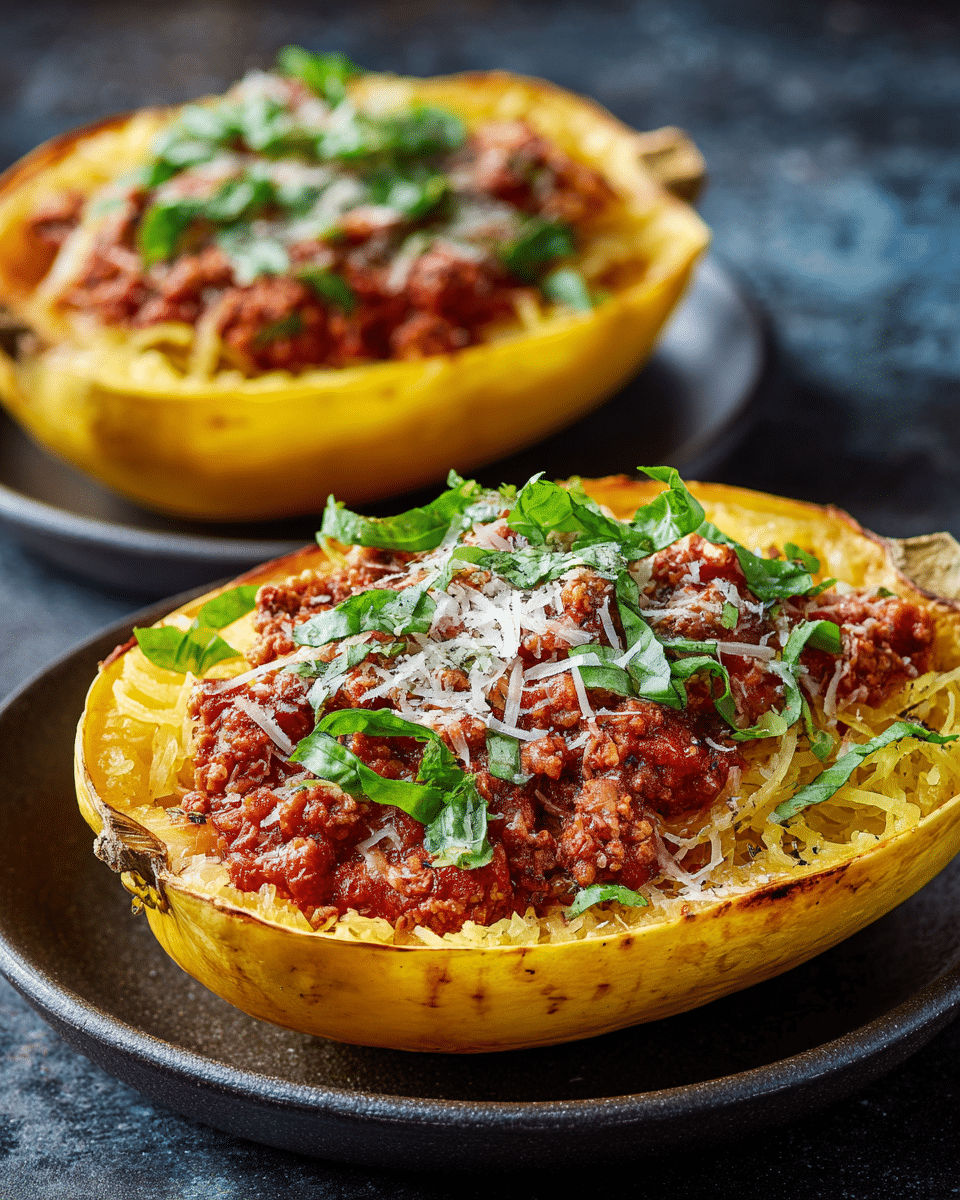This low-carb take on the classic Italian comfort dish replaces pasta with spaghetti squash, making it ideal for those managing blood sugar levels. Packed with veggies and lean protein, it’s hearty, healthy, and incredibly satisfying.
FULL RECIPE
Ingredients
- 1 medium spaghetti squash (about 3–4 lbs)
- 1 tablespoon olive oil
- 1 small onion, finely chopped
- 2 garlic cloves, minced
- 1 medium carrot, finely diced
- 1 celery stalk, finely diced
- 1 pound lean ground turkey or beef
- 1 (14.5 oz) can crushed tomatoes (no salt added)
- 2 tablespoons tomato paste
- 1 teaspoon dried oregano
- 1/2 teaspoon dried basil
- Salt and pepper to taste
- Fresh parsley or basil for garnish (optional)
- Grated Parmesan cheese (optional, for serving)
Directions
- Preheat the oven to 400°F (200°C). Cut the spaghetti squash in half lengthwise and scoop out the seeds.
- Place the squash halves cut-side down on a baking sheet. Roast for 35–40 minutes, or until the flesh is tender and easily shredded with a fork.
- While the squash roasts, heat olive oil in a large skillet over medium heat. Add onion, garlic, carrot, and celery. Cook for 5–6 minutes until softened.
- Add the ground turkey or beef to the skillet and cook until browned, breaking it up as it cooks.
- Stir in crushed tomatoes, tomato paste, oregano, basil, salt, and pepper. Simmer for 15–20 minutes until the sauce thickens.
- Once the squash is cooked, use a fork to scrape out the strands into a bowl.
- Serve spaghetti squash topped with Bolognese sauce. Garnish with fresh herbs and Parmesan if desired.
Nutritional Information
- Calories: 295
- Protein: 26g
- Carbohydrates: 18g
- Dietary Fiber: 5g
- Sugars: 8g
- Fat: 14g
- Saturated Fat: 3g
- Cholesterol: 65mg
- Sodium: 280mg
- Potassium: 760mg
Health Benefits of Spaghetti Squash Bolognese
Spaghetti squash Bolognese is a nutritious alternative to traditional pasta dishes, offering a lower carbohydrate content that benefits blood sugar control. Spaghetti squash itself is rich in vitamins like vitamin C and A, as well as fiber, which promotes digestive health and helps with satiety. The lean ground turkey or beef provides high-quality protein, essential for muscle repair and immune function. Combined, these ingredients make for a balanced meal that supports weight management and overall well-being.
Why Spaghetti Squash is Ideal for Diabetics
Spaghetti squash is a smart choice for those managing diabetes because it has a low glycemic index compared to regular pasta. This means it causes a slower, steadier rise in blood glucose levels, helping to avoid spikes that can be harmful. Its fiber content also aids in blood sugar regulation by slowing digestion and absorption of carbohydrates. Using spaghetti squash as a base instead of traditional noodles provides the comforting texture of pasta while maintaining blood sugar stability.
The Role of Lean Protein in This Recipe
Including lean protein such as ground turkey or lean beef in this Bolognese recipe is crucial for creating a filling, balanced meal. Protein helps slow the digestion of carbohydrates and promotes feelings of fullness, which can prevent overeating. It also supports muscle maintenance and metabolic health. Choosing lean cuts reduces saturated fat intake, which is better for heart health, especially important for those with diabetes or metabolic syndrome.
Vegetables and Flavor: The Importance of Carrots, Celery, and Onions
The addition of finely diced carrots, celery, and onions not only adds flavor complexity to the sauce but also boosts the nutrient density of the dish. These vegetables provide important vitamins, antioxidants, and fiber. They contribute to the savory, slightly sweet base typical of traditional Bolognese sauce while increasing the volume of food without adding many calories. This is a great way to make the meal more satisfying and nutritious.
Tomatoes and Heart Health
Tomatoes, used as crushed tomatoes and tomato paste in the sauce, are rich in lycopene, an antioxidant linked to improved heart health. Lycopene helps reduce inflammation and oxidative stress, which are risk factors for cardiovascular disease. The inclusion of tomatoes also provides vitamins C and K, potassium, and folate. Cooking tomatoes enhances the bioavailability of lycopene, making this dish not only delicious but also heart-healthy.
Spices and Herbs: More Than Just Flavor
The dried oregano and basil used in this recipe add more than aromatic flavor; they offer potential health benefits as well. Both herbs contain antioxidants and anti-inflammatory compounds. Oregano, for example, has been studied for its antimicrobial and immune-boosting properties. Fresh parsley or basil garnish adds a fresh burst of flavor and additional nutrients like vitamin K. Using herbs is a great way to enhance taste while reducing the need for excessive salt or unhealthy additives.
How Spaghetti Squash Bolognese Supports Weight Management
This recipe is naturally lower in calories and carbohydrates than traditional pasta dishes, making it ideal for weight management. The fiber from the squash and vegetables helps you feel full longer, reducing the likelihood of snacking or overeating later. The balanced protein content aids in preserving lean muscle mass during weight loss. Because it is nutrient-dense yet relatively low in calories, this meal supports a sustainable approach to maintaining or reducing weight.
Tips for Preparing the Perfect Spaghetti Squash
To get the best texture, roasting spaghetti squash until tender is key. Cooking it cut-side down on a baking sheet allows it to steam in its own juices, resulting in strands that resemble spaghetti. Scraping out the flesh with a fork creates the ideal noodle substitute. Avoid overcooking, which can make the squash mushy. This technique ensures a satisfying bite and pleasant mouthfeel, enhancing the overall enjoyment of the dish.
Variations to Customize Your Bolognese
This recipe is highly versatile. You can swap ground turkey for lean ground beef, chicken, or even plant-based protein alternatives. Adding mushrooms or finely chopped zucchini can increase the vegetable content without overpowering the flavor. For a spicier kick, red pepper flakes or smoked paprika can be incorporated. Adjusting herbs or using fresh tomatoes instead of canned can also change the taste profile. These options make the recipe adaptable to different dietary needs and preferences.
Pairing Suggestions for a Complete Meal
Spaghetti squash Bolognese pairs well with simple side dishes like a crisp green salad or steamed vegetables, which add freshness and more fiber. A light vinaigrette can complement the richness of the sauce. For an extra boost, a side of sautéed leafy greens like spinach or kale can be included. This combination creates a balanced plate with varied textures and flavors while keeping the meal nutritious and diabetes-friendly.
Storing and Reheating Tips
Leftovers of this dish store well in the refrigerator for up to 3-4 days, making it convenient for meal prep. When reheating, gently warm the sauce and squash separately to maintain texture and flavor, then combine before serving. Avoid overheating to prevent drying out the squash or making the sauce too thick. You can also freeze portions for up to 2 months, though fresh is best for optimal taste and texture.
The Cultural Roots of Bolognese Sauce
Traditional Bolognese sauce originates from Bologna, Italy, where it is typically made with a mix of ground meats, soffritto (onion, carrot, celery), wine, and milk or cream. This recipe adapts that classic by using spaghetti squash instead of pasta to suit modern dietary preferences without losing the essence of the hearty, slow-cooked sauce. Understanding this heritage helps appreciate how traditional recipes can evolve while maintaining their comforting appeal.
Conclusion
Spaghetti squash Bolognese is a delicious and health-conscious twist on a beloved classic. Its combination of nutrient-rich vegetables, lean protein, and a low-carb pasta alternative makes it especially suitable for those managing diabetes or seeking weight-friendly meals. The dish’s balance of flavors, textures, and nutrients supports overall health, heart function, and blood sugar control while satisfying cravings for comfort food. With simple preparation and endless customization options, this recipe is a versatile and wholesome addition to any meal rotation.






